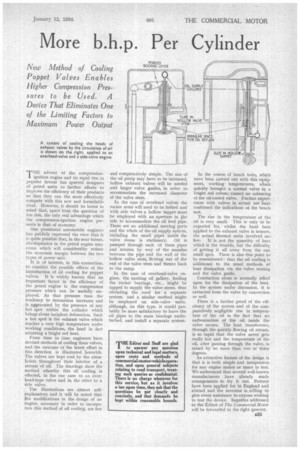More b.h.p. Per Cylinder
Page 53

If you've noticed an error in this article please click here to report it so we can fix it.
New Method of Cooling Poppet Valves Enables Higher Compression Pressures to be Used. A Device That Eliminates One of the Limiting Factors to Maximum Power Output
MHE advent of the compression
]. ignition engine and its rapid rise in popular favour has spurred designers of petrol units to further efforts to impr3ve the efficiency of their products so that they can the more effectively compete with this new and formidable rival. However, it should be borne in mind that, apart from the question of fire risk, the only real advantage which the compression-ignition engine presents is that of economy.
One prominent automobile engineer has publicly expressed the view that it is quite possible that, in the near future, developments in the petrol engine may ensue which will considerably reduce the economic margin between the two types of power unit.
It is of interest, in this connection, to consider the possible effects of the introduction of oil cooling for poppet valves. It is widely known that an important • factor in the efficiency of the petrol engine is the compression pressure which can be usefully employed. As that pressure rises the tendency to detonation increases and is aggravated by the presence of any hot spot within the cylinder which brings about incipient detonation. Such a hot spot is the exhaust valve which reaches a very high temperature under working conditions, the head in fact attaining a bright red heat.
From time to time engineers have devised methods of cooling these valves, and the outcome of the latest effort in this direction is illustrated herewith. The valves ire kept cool by the circulation throughout their interior of a stream of oil. The drawings show the method whereby this oil cooling is effected, in the one case to an overhead-type valve and in the other to a side valve.
The illustrations are almost self-. explanatory and it will be .noted that ,the modifications in the design of an engine, necessary in order to incorporate this method of oil cooling, are few and comparatively simple. The size of the oil pump may have to be increased, hollow exhaust valves will be needed and larger valve guides, in order to accommodate the increased diameter of the valve stem.
In the case of overhead valves the rocker arms will need to be forked and with side valves a hollow tappet must be employed with an aperture in ;he side to accommodate the oil feed pipe. There are no additional moving parts and the whole of the oil supply system, including the small pipes inside the valve sterns is stationary. Oil is pumped through each of these pipes and returns by way of the annulus between the pipe and the sail of the hollow valve stem, flcwing out of the end of the valve stem and thence back to the sump.
In the case of overhead-valve engines, the existing oil gallery, feeding the rocker bearings, etc., might be tapped to supply the valve stems, thus obviating the reed for a separate system, and a similar method might be employed on side-valve units, although, on this type, it would probably be more satisfactory to leave the oil pipes to the main bearings undistorted, and install a separate system. In the course of bench tests, which have been carried out with this equipment, working temperatures, which quickly brought a normal valve to a bright red colour, caused no coloming of the oil-cooled valve. Further experiences with valves in actual use have confirmed the indications of the bench test.
The rise in the temperature of the oil is very small. This is only to he expected for, whilst the local heat applied to the exhaust valve is intense, the actual thermal units involved are. few. It is not the quantity of heat which is the trouble, but the difficulty of getting it all away from the one small spot. There is also this point to be remembered : that the oil cooling is additional to the usual methods of heat dissipation via the valve seating and the valve guide.
Conduction alone is normally relied upon for the dissipation of the heat. In the system under discussion, it is extracted from the valve by convection as well.
There is a further proof of the efficiency of the system and of the comparatively negligible rise in temperature of tbe oil in the fact that no carbonization of the oil inside the valve occurs. The heat transference, through the quickly flowing oil stream, is so rapid that the valve never gets really hot and the temperature of the oil, after passing through the valve, is raised by no more than two or three degrees.
An attractive feature of the design is that it is both simple and inexpensive for any engine maker or tuner to test. We understand that several well-known manufacturers have already made arrangements to try it out. Patents have been applied for in England and abroad and the inventor is willing to give every assistance to anyone wishing to test the device. Inquiries addressed to the Editor of The Commercial Motor will be forwarded to the right quarter.




































































































